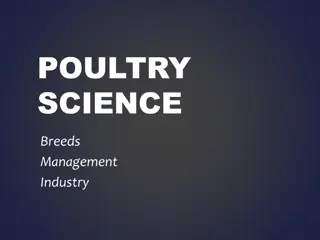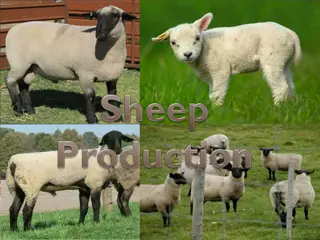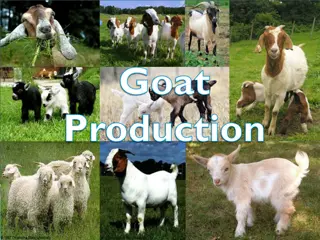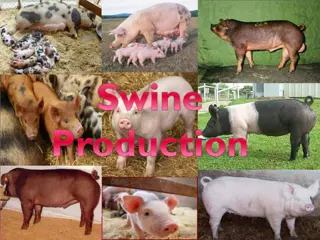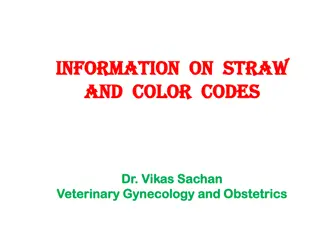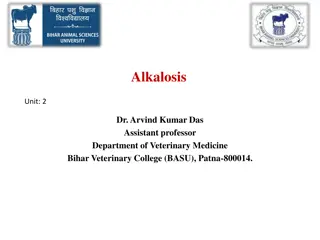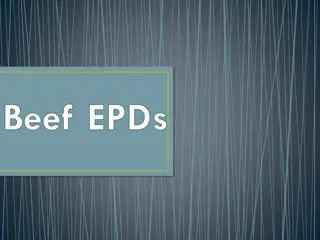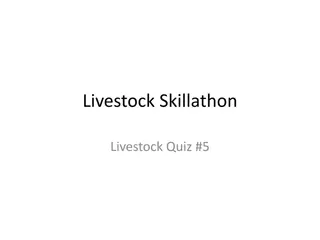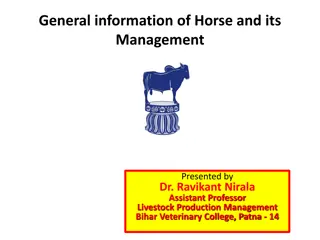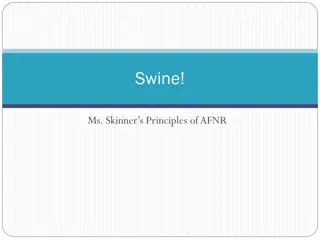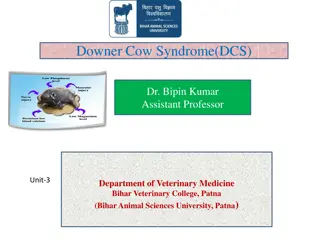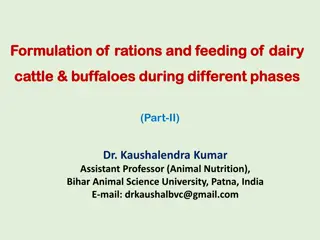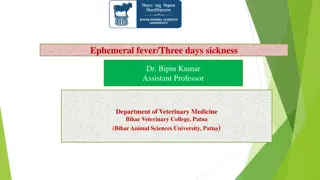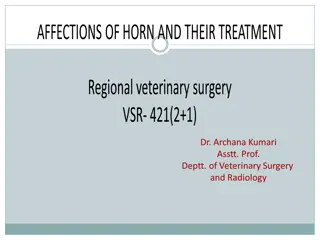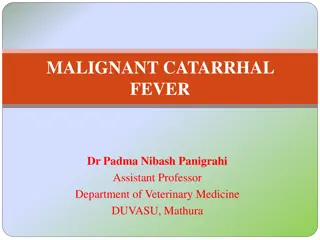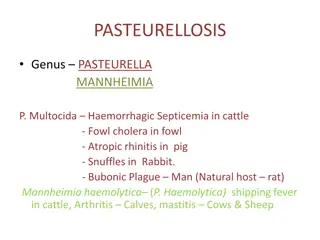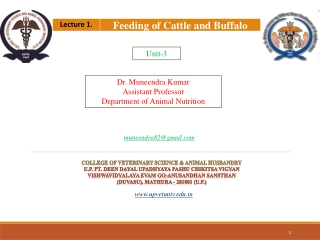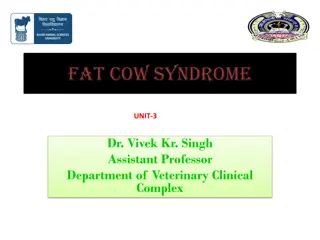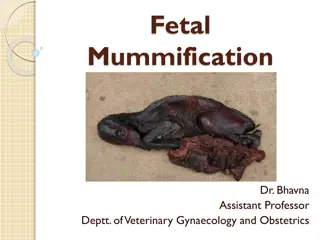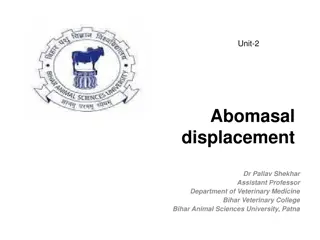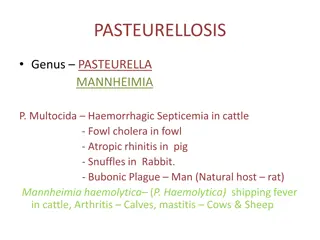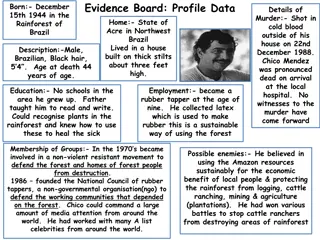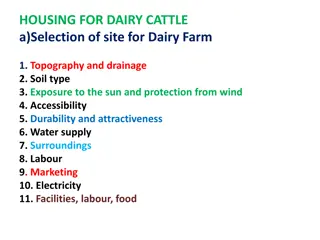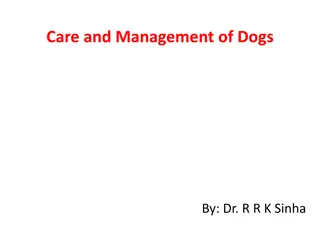Comprehensive Guide to Cattle Breeds, Management, and Terminology
Explore the world of cattle with a detailed overview of key terms, breeds like Ayrshire and Brown Swiss, management practices, and terminology such as parturition and TMR. Enhance your knowledge about heifers, steers, and animal behavior, growth, development, and health evaluation.
Download Presentation

Please find below an Image/Link to download the presentation.
The content on the website is provided AS IS for your information and personal use only. It may not be sold, licensed, or shared on other websites without obtaining consent from the author. Download presentation by click this link. If you encounter any issues during the download, it is possible that the publisher has removed the file from their server.
E N D
Presentation Transcript
OBJECTIVES Key Terms Cattle Terminology Breeds Management Practices and Facilities Feeding Heifers and Steers Animal Behavior Animal Growth and Development Animal Health Evaluation
PARTURITION The action or process of giving birth to offspring. Holstein
FINISHING Usually refers to the final feeding stage when the animals are fed high concentrations of grain to add fat (marbling) to the meat.
TMR Total Mixed Ration Most show feeders use this.
AGD Average Daily Gain
Bull Sexually mature male Angus
Cow A female that has produced a calf Red Angus
Heifer A female that has not produced a calf Limousin
Steer Castrated male Brahman
Calf A young animal (less than a year old) of either sex
AYRSHIRE Originated in Scotland Medium sized breed Medium to dark red and white in color Average lactation 305 days of 14,534 lbs. milk
BROWN SWISS Originated in Switzerland Large docile breed Hair is brown of various shades Average lactation 305 days of 16,135 lbs. of milk
GUERNSEY Originated on the Isle of Guernsey Medium size breed know for gentle nature Various shades of fawn with white markings and a white switch Average lactation 305 days of 13, 109
HOLSTEIN Originated in the Netherlands Dominant breed of dairy cattle Black and white color pattern (red and white exist) Average lactation 305 days of 20,121 lbs. of milk
JERSEY Originated on the Isle of Jersey A small, refined animal of unsurpassed femininity Vary from light tan to dark fawn with darker shading around the head and lower legs Average milk yield of 13,358
ANGUS Originated in Scotland Black, naturally polled Largest number of annual registrations in the United States
HEREFORD Originated in England Red and white, also white on underline, legs, switch etc. Found in all 50 states
POLLED HEREFORD Developed in the United States Red with white face, also white on underline, legs, switch, etc. Naturally hornless
RED ANGUS Developed in the United States Red and naturally polled Developed from a recessive gene found in black Angus cattle
SHORTHORN Originated in England Three main colors: red, white and roan Used for milk and meat
CHIANINA Originated in Italy White hair coat with black pigmentations One of the world s oldest breeds Extremely large framed
CHAROLAIS Originated in France White, off-white to cream coloration Produce lean, muscular carcasses Below average maternally
GELBVIEH Originated in Germany Reddish gold to russet colored hair Resulted from government controlled breeding program (W. Germany) Dual purpose breed
LIMOUSIN Originated in France Reddish gold in color, can also be black Fastest growing breed in country (percentage increase in registrations)
MAINE ANJOU Originated in France Deep red in color with white underline and patches, can also be black Largest continental breed in terms of weight
SIMMENTAL Originated in Switzerland Range in color from straw colored through light red and dark red, also black Heaviest milking continental breed
TEXAS LONGHORN Developed in Texas, of Spanish origin Long, distinctive horns, many colors including speckled and spotted
BRAHMAN Originated in India Red and grey strands Noted for heat tolerance, disease and insect resistance and crossing ability
BRANGUS Developed in the United States 5/8 Angus and 3/8 Brahman, black and naturally polled
SIMBRAH Developed in the United States 5/8 Simmental and 3/8 Brahman
SANTA GERTRUDIS Developed in the United States 5/8 Shorthorn and 3/8 Brahman Dark red, both horned and polled
BEEFMASTER Developed in the United States About 50% Brahman, 25% Shorthorn and 25% Hereford No set color pattern
METHODS OF IDENTIFICATION Combination of tattoo and ear tag Hot or Fire branding Freeze branding Electronic ear tags
Tattoo and Ear Tag Tattoo is permanent set of digits placed in the ear by using ink Ear tags are placed on the outside of the ear Tattoo s are better than ear tags because they are on the animal permanently.
Branding the hide with hot irons One of the oldest and most permanent methods of Identification! Branding is usually the best method because it can never fade away! Hot or Fire branding
Freeze Branding Branding cattle with super chilled irons Hair is discolored on branded spot due to the extreme cold. Great on black cattle
Electronic Ear tags Very new and very expensive Allows animal or carcass to be traced back to place of origin
WHY CASTRATE? Steers are more docile in temperament Steers produce a carcass with finer texture of lean and more marbling Steers will usually finish in a little less time (fatten quicker) Steers can be mixed with females Castration eliminates the possibility of genetically inferior bulls breeding cows
WHY DEHORN? Losses from horn bruises are eliminated at slaughter time or in marketing Reduces injury to men and horses when working cattle Cattle without horns sell for higher prices Less shed and feeding space required Look more uniform in groups



